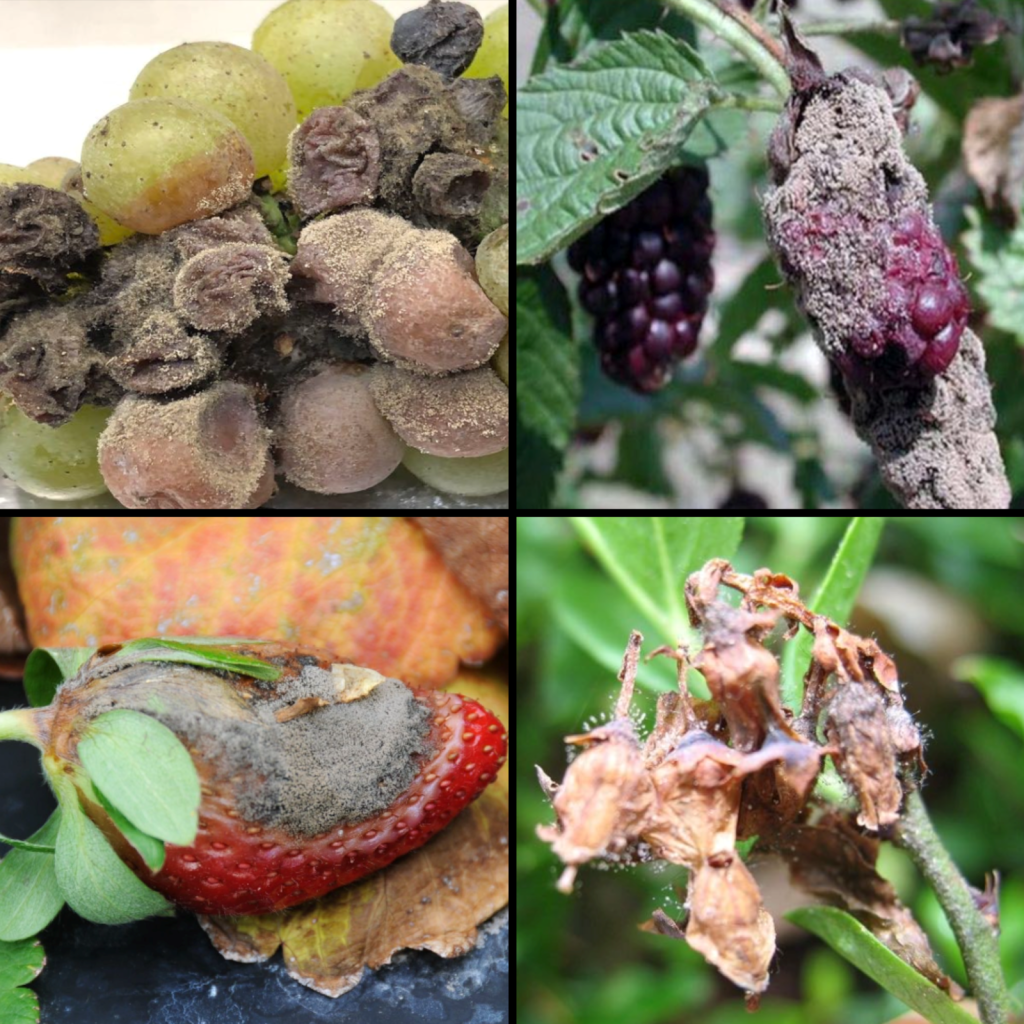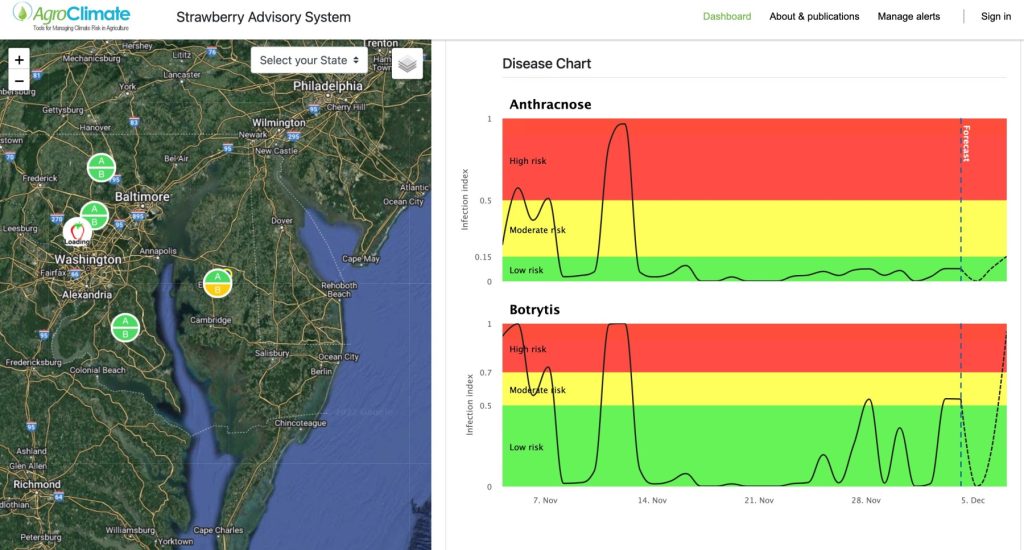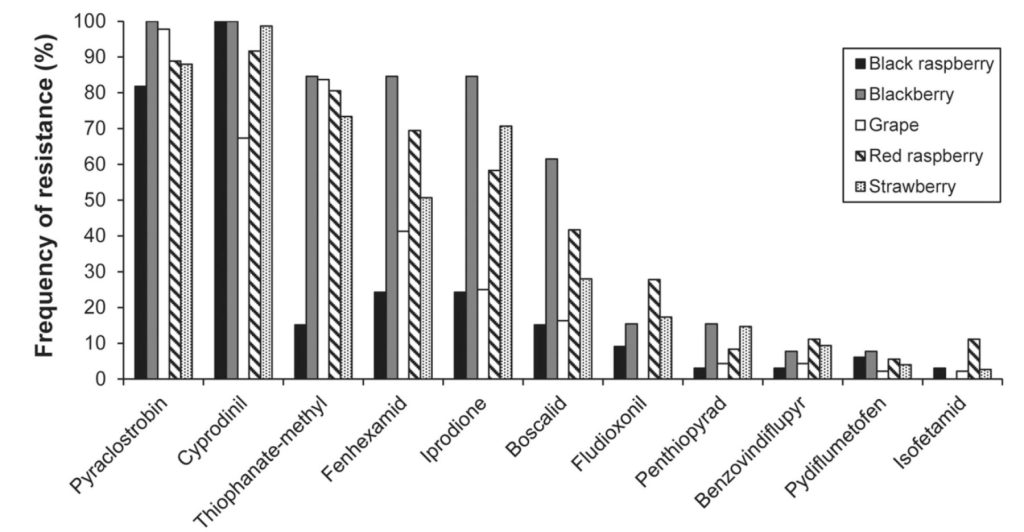Scott D. Cosseboom and Mengjun Hu, Department of Plant Science and Landscape Architecture, University of Maryland
Botrytis cinerea is a fungus that causes disease in many crops. Most notably, it causes gray mold of strawberry and Botrytis bunch rot of grape (Fig. 1). This pathogen can be spread by wind and rain and can overwinter on leaf debris and fruit mummies. On some fruit like strawberries, the disease has a “latent period,” meaning that infection and symptom development happen at different times. On strawberries, infection can occur at bloom, while disease symptoms appear at fruit ripening or post-harvest.

However, B. cinerea is only able to infect under appropriate weather conditions. Researchers have found that particular combinations of temperature and leaf wetness duration are critical for infection to occur. Disease prediction and spray warning system models are currently available for strawberry gray mold through Agroclimate (Fig. 2). These warning systems have been demonstrated to be effective for triggering preventative fungicide applications. In field trials they triggered fewer fungicide applications than a calendar-based spray program while maintaining an acceptable level of disease control (Hu et al. 2021).

Cultural methods that reduce humidity or wetness or aid in the drying of the plant canopy tend to be effective in reducing Botrytis fruit rots. In strawberry, not much research has been conducted on cultivar susceptibility to gray mold. However, cultivars with flowers and fruit with an upright stature and with a calyx that grows away from the fruit can more easily dry out, which may reduce disease incidence. In grapes, cultivars with fewer pores on the berry skin and thicker skin are more resistant to Botrytis bunch rot. Also, the use of plastic tunnels and plastic mulch in strawberries and pruning techniques to reduce canopy density around the fruit zone in grapes can reduce the plants’ exposure to excess water/humidity, thereby lowering the incidence of gray mold.
The ability of this fungus to cause disease in many crops indicates just how adaptable it can be. It is also adaptable to fungicides, and fungicide-resistant populations have developed worldwide. From 2014 to 2019, we collected Botrytis from strawberries, blackberries, red raspberries, black raspberries, and grapes, and found that fungicide resistance was widespread in each crop. Samples were collected in Maryland and Pennsylvania. We evaluated isolates for their sensitivity to all currently registered conventional fungicides except for the multisite fungicides captan and thiram, to which resistance is not a concern. The isolates were most frequently resistant to the FRAC 1 (e.g., thiophanate-methyl), FRAC 2 (e.g., iprodione), FRAC 9 (e.g., cyprodinil), FRAC 11 (e.g., pyraclostrobin), and FRAC 17 (e.g., fenhexamid) fungicides. The isolates were only sensitive to two fungicide groups, FRAC 7 (e.g., boscalid, penthiopyrad, benzovindiflupyr, pydiflumetofen, and isofetamid) and FRAC 12 (e.g., fludioxonil) (Fig. 3).

The development of resistance has limited the effective options for controlling Botrytis fruit rots. This may lead to increased usage of newer FRAC 7 and FRAC 12 fungicides, which in turn, could exacerbate resistance development. To prevent resistance development, it is important to embrace resistance management techniques. First, spray only when necessary. This can be aided by the implementation of spray warning systems, like those mentioned above. Also, cultivars known to be more resistant to Botrytis may require less fungicide input. Some crops such as grapes have phenology-related susceptibility to Botrytis, meaning that season long fungicide protection is unnecessary. Secondly, base the spray program on the multisite fungicides captan or thiram, or other materials that have low risk for resistance development.
In summary, the fungus B. cinerea is a troublesome pathogen in multiple crops including small fruits. Control of Botrytis fruit rot diseases can be aided by both cultural methods that reduce humidity and wetness experienced by the fruit and chemical methods (fungicides). Fungicides can be highly effective for prevention of these diseases, but resistance is a major concern. Good stewardship of the remaining effective fungicides through resistance management strategies may prolong the effective life span of the fungicide products.
Cosseboom, S. D., and Hu, M. 2021. Identification and characterization of fungicide resistance in Botrytis populations from small fruit fields in the Mid-Atlantic United States. Plant Dis. doi:10.1094/PDIS-03-20-0487-RE.
Hu, M., Cosseboom, S. D., Schoeneberg, A., Johnson, C. S., Peres, N. A., and Lea-Cox, J. 2021. Validation of the Strawberry Advisory System in the Mid-Atlantic region. Plant Dis. 105:2670–2679.